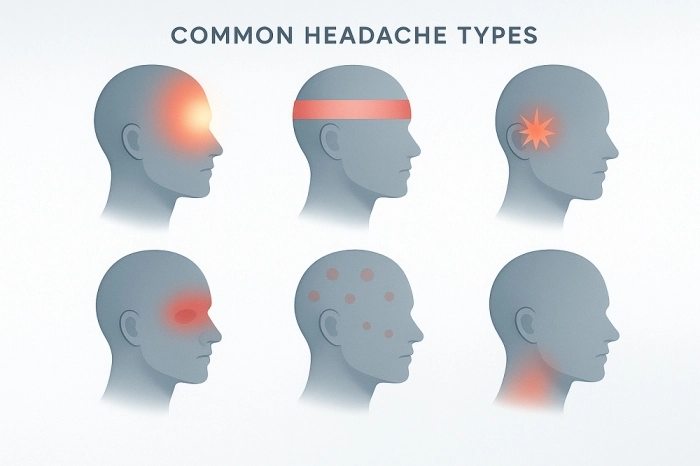- July 26, 2025

Headaches are one of the common health complaints that can have a wide array of causes. They can range from the occasional dull ache across the forehead to a sharp pain at the back of your head. The symptoms, cause, and meaning of the pain can vary depending on the headache location.
Headache and migraine related issues can affect a large portion of the population in the United States alone. In this article, we will explore the various types of headaches, their locations, and the different types of headaches, as well as how to manage them effectively. Let’s dive in!
What Are The Common Headache Types?
Understanding the common types of headaches is the first step to understanding the cause of pain and getting adequate relief. Majorly, the different types of headaches are divided into two categories: primary and secondary headaches, encompassing approximately 150 distinct classifications. The most common headache types include:
Migraine headaches
This is among the most common types of headaches. They are usually characterized by a throbbing pain that is generally on one side of the head. Migraine headaches occur due to sensitivity to bright light and loud sounds.
Tension headaches
Tension headaches often start due to tension and stress. The muscle tension and stress can typically feel like a tight band or pressure around the head. The symptoms usually get worse in the afternoon and evening and are accompanied by general fatigue.
Cluster headaches
This is characterized by severe pain in one particular area of the head. The pain mostly starts behind one of the eyes and is often accompanied by redness, tearing of the eyes, and stuffy noses. These headaches can last anywhere from fifteen minutes to up to three hours.
Sinus headaches
It occurs when the sinuses become blocked, which causes pressure to build in the head. Symptoms include unbearable pain in the front of the head, nausea, and stuffy or runny nose.
Rebound Headache
Rebound headaches result from the frequent, unprescribed use of painkillers. They often cause comparatively dull but daily pain across various headache locations. This type of headache highlights medication overuse and requires professional guidance for long-term relief.
Cervicogenic Headache
Cervicogenic headaches originate from neck issues and radiate upward. While commonly felt at the back, pain may extend to the forehead, mimicking other location types of headaches.

Headache Locations and Their Meanings
Understanding the root cause of your headache can help identify the different types of headaches you’re experiencing. The headache placement meaning, whether it’s on the forehead, one side, or the back, often reveals the pain location and required treatment. Below are common headache locations and their potential indications.
Headache in Front of Head / Across Forehead
Pain that starts at the front of the head and spreads across the forehead is usually associated with tension-type headaches or sinus congestion.
Frontal headache pain is often dull but persistent. Triggered by stress, poor posture, or excessive screen time, it can also result from eye strain or dehydration. Recognizing the meaning of this headache area helps in choosing the best-suited lifestyle changes or other relief remedies.
Headache on One Side of Head
Either left or right, a headache on one side of the head is a significant sign of migraine. These headaches are often intense, intolerable, and distressful.
Common migraine symptoms include nausea, light sensitivity, dizziness, tingling, temporary weakness, neck stiffness, and visual disturbances. Common migraine locations include the temples, behind one eye, or even extending to the jaw. Among all types of headaches, migraines are one of the most disruptive due to their severity and duration.
Headache at the Back of the Head
Pain in the back of the head may indicate tension headaches and cervicogenic headaches. If the pain stems from the neck and radiates upward, it’s likely related to posture or spinal issues. The back of the head headache is often muscular, but can occasionally reflect more serious conditions. Always assess the full context to determine the location, meaning, and causes of the headache.
Headache Around Eyes or Temples
Pain centered around the eyes or temples may indicate cluster headaches, migraines, or sinus symptoms.
Cluster headaches are typically sharp, cyclical, and affect the eyes, causing tears and redness. In this headache placement, inflammation or vascular changes are usually the underlying mechanism. It’s a different type of headache and often requires targeted intervention.
Diffuse or Whole-Head Pain
Whole head pain is the pain that spreads throughout the entire head. It may be a rebound headache, a result of medication overuse, or systemic triggers like sleep deprivation or viral infections.
This headache area’s meaning is less specific but often points to lifestyle issues or overmedication. Understanding the meaning and causes of this headache location can help with long-term prevention strategies.
Read Also: Tips to Manage Headaches and Migraines
Types of Headaches and Their Causes
Headaches and their causes come in many forms, each with distinct triggers and symptoms. Understanding the types of headaches and their causes is key to choosing the right treatment and preventing recurrence.
What Are the Causes of Headaches?
- Stress and anxiety
- Dehydration musculoskeletal problems
- Lack of sleep
- Diet triggers
- Caffeine withdrawal
- Eye strain
- Alcohol
- Hormonal imbalance
- Side effects from medications
| Type of Headaches | Primary Causes | Notable Symptoms |
| Tension | Stress, muscle tightness | Dull, pressing pain |
| Migrane | Hormonal, neurological | Throbbing, nausea, aura |
| Sinus | Infection, allergies | Facial pressure, congestion |
| Cluster | Brain signaling abnormality | Eye pain, tearing, frequent attacks |
| Rebound | Medication overuse | Daily pain, often in morning |
| Cervicogenic | Neck problems | Pain from neck to head |
Headache Placement Meaning and Diagnosis
All types of headaches have different headache placements and meanings. Let’s take a look at some of the common locations of headache pain.
Where Are the Common Locations of Headache Pain?
Headache pain can occur in various areas of the head, and each location typically indicates a specific type or underlying cause. Identifying the location of the headache helps in understanding its meaning and finding the most effective relief. Each headache spot offers suggestions for a better lifestyle.
- Pain on the forehead = tension or sinus
- Pain at the back = cervical spine involvement
- Around the eyes = cluster headache or sinus issue
What Are the Possible Treatments For Headaches?
Headache pain can occur in various areas of the head, and each location typically indicates a specific type or underlying cause. Identifying the location of the headache helps in understanding its meaning and finding the most effective relief. Each headache spot offers suggestions for a better lifestyle.
- Pain on the forehead = tension or sinus
- Pain at the back = cervical spine involvement
- Around the eyes = cluster headache or sinus issue
What are the possible treatments for headaches?
Several treatments are available to help reduce the intensity of your headaches and minimize their frequency. Here are some of the possible treatments for headaches:
- Over-the-counter medications
- Prescription medications
- Hydration
- Balanced diet
- Stress management techniques
- Regular sleep schedule
- Limiting screen time and improving posture
- Physical therapy
- Avoiding known triggers
- Cold or warm compresses
- Behavioral therapy or counseling
Conclusion
Are you suffering from severe headaches? Don’t wait; seek medical attention now! Visit Windermere Medical Clinic for the best, fastest, and most compassionate care. From tension to migraine to cluster headaches, your headache placement matters more than you think. Our experienced medical personnel will take the time to understand your needs and provide targeted care, giving you the relief you need to get back to feeling your best.
FAQ
01. What do different headaches mean?
A headache on the forehead, mainly a headache across the forehead, often indicates tension or sinus pressure rather than neurological causes.
02. What kind of headache do I have?
If it’s a forehead headache, it’s likely to be tension- or sinus-related, depending on the pressure and triggers. The kind of headache depends on your symptoms and location of pain.
03. What do different headaches mean?
A headache at the front of the head typically means stress or eye strain, while migraines and clusters affect deeper regions of the brain.
04. What are the different types of headaches?
Types of headache include tension, migraine, sinus, and rebound. A headache with a forehead pattern usually falls under the categories of tension-type or sinus headaches.
***
The material contained on this site is for informational purposes only and DOES NOT CONSTITUTE THE PROVIDING OF MEDICAL ADVICE, and is not intended to be a substitute for independent professional medical judgment, advice, diagnosis, or treatment. Always seek the advice of your physician or other qualified healthcare provider with any questions or concerns you may have regarding your health
Recent Post





